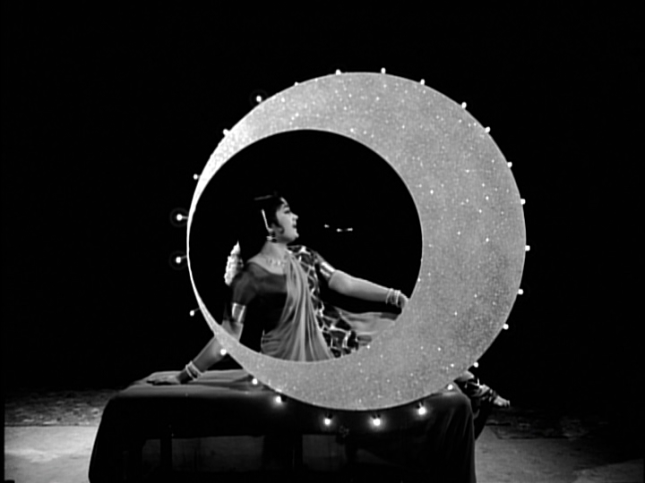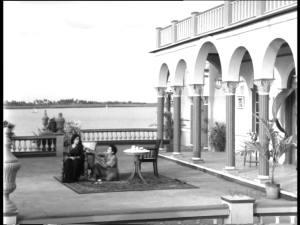There is nothing new in B. Gopal’s film, but we all know that Chiranjeevi and ANR are the drawcard.
Parvathi (Shubha) gives birth to a baby boy in the home of a stranger, Mahalakshmi (Sharada). She’s on the run from goon and soon afterwards she takes little Ravi and leaves town. Many years later Ravi (Chiranjeevi) ends up working for Jagannatham (Akkineni Nageshwara Rao) at his garage. He also pesters Jagannatham’s daughter Chitti (Vijayashanti) and of course, despite his appalling ideas of what constitutes “wooing”, she falls for him too. But there can be no mass film without birth secrets and fateful coincidence! Parvathi comes for the engagement and shock horror, she is Jagannatham’s estranged sister. And Ravi’s father is Bad News. It turns out that Ravi’s father Narayana framed Jagannatham for murder. So Ravi and Chitti both impersonate illegitimate children of Narayana and move into the big house to get their revenge. How will true love win? Was Brahmi necessary? Will Sharada come back at the end of the film to make a very important decision? Will Ravi reunite the good bits of the family?
It’s a good thing I could have answered all of those questions without seeing the film as I watched this on Youtube without subtitles. Subtlety and nuance would have been quite trying. And a big sarcastic thank you to people who add huge ugly watermarks to their video uploads.
Chiru is in his mass element here, but he doesn’t phone it in. He gets an excellent and surprisingly low key entrance via a bank of TV screens, but that quickly turns into Ravi being thrown through a window and into an adjoining body building gym for the fight part deux. He’s an atypical hero in some ways because the bad guys actually land a few punches. After being sacked for destroying his employer’s TV shop, Ravi saves Jagnnatham from a runaway car and scores himself a new job.
Chiru’s chemistry with ANR is delightful. It’s not often you see the Megastar consciously making room for his co-stars, or a co-star that takes it right up to the Megastar. Jagannatham spots Ravi moping, draped across his car bonnet, and decides to coach him in the ways of being a man – specifically drinking, dancing and romancing.
In the ebullient Guruva Guruva, you can see Chiru watching ANR, one of the original Telugu dancing heroes, and make small changes to his own timing and movement to keep in synch with his sprightly 70 year old partner. It’s always a bit disconcerting seeing fine actors with nothing much to do, but both deliver good solid performances despite the lacklustre material. Their scenes when Jagannatham refuses to accept Ravi have a bit of cheese and a bit of real pathos, as though neither could help themselves and had to add some quality emoting.
Poor Vijayashanti. Ravi’s approach to Chitti was of the treat them mean and they’ll find you irresistible school of thought. The same school that turned out generations of sex pests. Luckily Ravi is coached in the ways of over acting by Jagannatham. Although since Chitti was only written into the film to be his True Love and dance partner when ANR wasn’t available, did it make a real difference? Chitti does fight back in doomed attempts to free herself of Ravi’s presence, and those scenes at least give Vijayshanti something to do other than squeal and/or giggle. Once Chitti succumbs to Ravi’s advances, she is allowed into songs. She comes into her own for the dances although there she has to battle the wardrobe department.
I enjoyed the song picturisations a lot. They really play up to the Megastar image, as well as giving Chiru a range of choreographic and costume styles to showcase his charms. And he did solve the vexing question of how to manage many costume changes efficiently by having his backing dancers tear layer after layer of clothing off him.
The action scenes are varied. The intro fight incorporated a wide range of gym apparatus. I liked the longwinded rickshaw chase. Ravi fights on and off and under the rickshaw as the baddies keep coming and show how bad they are by not respecting a ma in mid cardiac arrest. Or maybe the quarry scene which kept me wondering “who, apart from antlions, buries themselves under a mound of gravel and waits for their prey to stroll by?” The comedy fight to impress Chitti was less delightful. I did kind of like the bit where Ravi throws Babji (Brahmi) on to a passing car to cause an accident. That’s a whole lot of confidence and a cavalier attitude to your friends on display right there. And I hope it hurt Brahmi as much as having to watch his shenanigans hurt me.
Apart from the usual comedy uncles (Ali is the least annoying), the supporting actors are underutilised. I got my hopes up when I saw Sharada in the opening scenes but she disappears until almost the end. She does play an important part in the final conflict but it wasn’t a satisfying role. Shubha is more present but also mostly silent. Satyanarayana and Kota Srinivasa Rao are the baddies, one calculative and one more bumbling.
See this for ANR with Chiru, and the songs. Everything else is OK but not amazing. 3 ½ stars!





































































